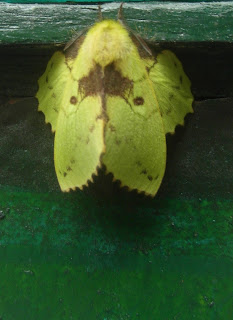Just returned from 10 days in Gangtok (Sikkim). Ran a very successful moth trap at the Hidden Forest Retreat and a few of the more striking images from here and elsewhere on the visit are included here. The first moth has the splendid name of Baorisa hieroglyphica and was actually found at the Guru Padsamabhava statue that functions like a giant moth trap when illuminated at night. The second moth looks exactly like a rolled leaf from the side. Number 3 is a Lappet moth from Rumtek monastery. Number 4 is Asota caricae and the 5th is probably Vamuna alboluteola. The 6th picture is of day-flying moths with very striking sexual dimorphism from a puja near the city centre. Lastly, there is a hawk moth larva from the gardens of our accommodation. There were also lots of other vertebrates and invertebrates that will feature as I sort them through. This is only a taster!
This blog may help people explore some of the 'hidden' issues involved in certain media treatments of environmental and scientific issues. Using personal digital images, it's also intended to emphasise seasonal (and other) changes in natural history of the Swansea (South Wales) area. The material should help participants in field-based modules and people generally interested in the natural world. The views are wholly those of the author.
Sunday, 23 September 2012
Himalayan Action
Just returned from 10 days in Gangtok (Sikkim). Ran a very successful moth trap at the Hidden Forest Retreat and a few of the more striking images from here and elsewhere on the visit are included here. The first moth has the splendid name of Baorisa hieroglyphica and was actually found at the Guru Padsamabhava statue that functions like a giant moth trap when illuminated at night. The second moth looks exactly like a rolled leaf from the side. Number 3 is a Lappet moth from Rumtek monastery. Number 4 is Asota caricae and the 5th is probably Vamuna alboluteola. The 6th picture is of day-flying moths with very striking sexual dimorphism from a puja near the city centre. Lastly, there is a hawk moth larva from the gardens of our accommodation. There were also lots of other vertebrates and invertebrates that will feature as I sort them through. This is only a taster!
Subscribe to:
Post Comments (Atom)
It's All Downhill Now
The snowline is climbing in the French Alps. This has resulted, thus far, in the closure of 186 ski resorts. This figure is like...

-
I n the UK and US, a pparently popular and successful vegan/vegetarian restaurants are reportedly closing or adding meat to their menus ( ...
-
Early ripening fruit may seem convenient but some folk think it confirms environmental stress. There's also a possibility th...








%20mating%20NWCW.jpg)


2 comments:
Utterly amazing creatures, Paul!
I was thrilled earlier in the year to see my first Swallowtail caterpillars (11 of them) in Norfolk (where I spent my teenage years).
I agree- they are certainly an impressive bunch!
Post a Comment